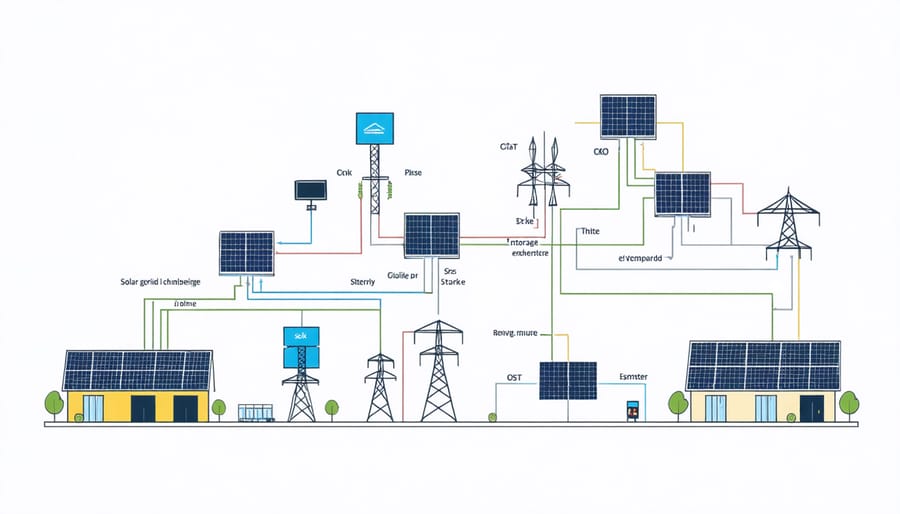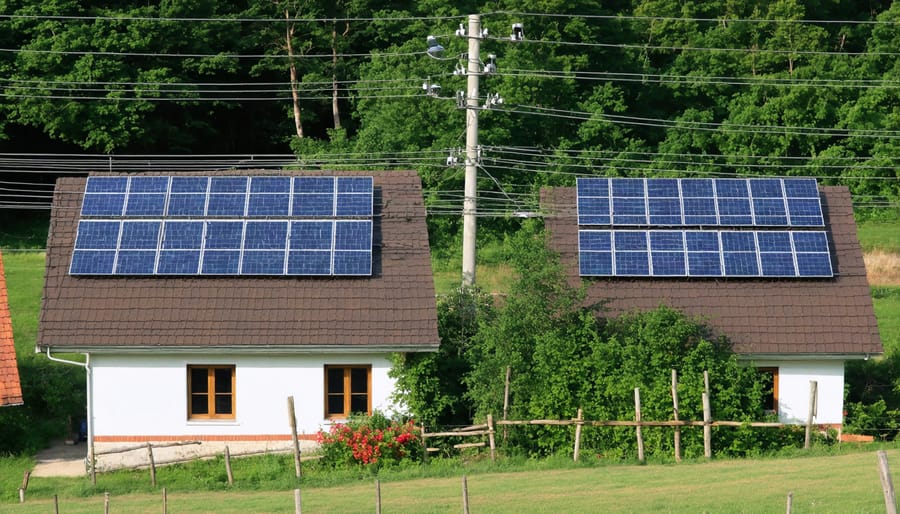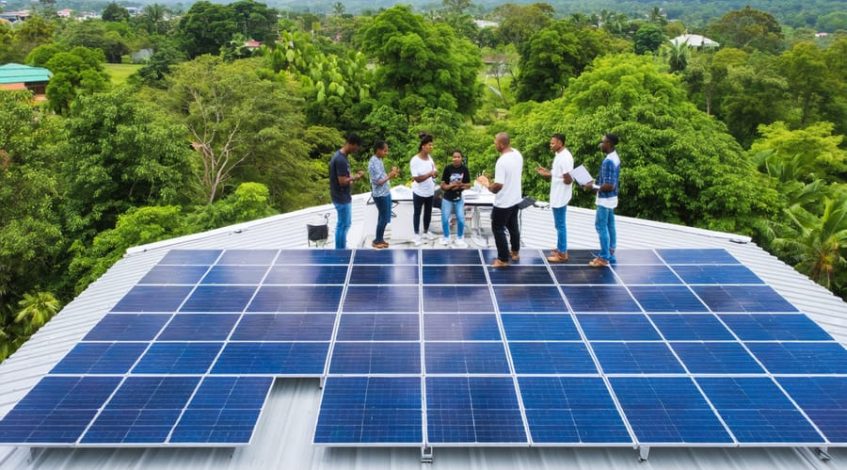Solar microgrids are revolutionizing energy independence for communities worldwide, offering a powerful solution to unreliable power infrastructure and rising energy costs. These localized power systems combine solar panels, energy storage, and smart distribution networks to create self-sustaining energy ecosystems that can operate independently or in conjunction with the main power grid.
By implementing solar microgrids, organizations and communities can achieve energy autonomy while reducing operational costs by 20-30% on average. These systems have proven particularly valuable in remote locations, industrial facilities, and developing regions where traditional grid infrastructure is unreliable or non-existent.
Recent technological advances have made solar microgrids more accessible and cost-effective than ever before. Modern systems incorporate sophisticated energy management software, high-efficiency solar panels, and advanced battery storage solutions, enabling 24/7 power availability with minimal maintenance requirements. Leading organizations across healthcare, manufacturing, and municipal sectors are increasingly adopting these systems to ensure operational resilience and meet sustainability goals.
The growing trend toward community-based financing models has made solar microgrid implementation more feasible for diverse stakeholders. Through power purchase agreements (PPAs), cooperative ownership structures, and innovative funding mechanisms, communities can now access the benefits of solar microgrids without substantial upfront capital investment.
How Solar Microgrids Revolutionize Community Energy
Technical Components of Community Solar Microgrids
Community solar microgrids comprise several key technical components that work together to generate, store, and distribute power efficiently. At the core is the solar photovoltaic (PV) array, which converts sunlight into electricity. These arrays incorporate latest solar technology advances to maximize energy capture and conversion efficiency.
The system architecture includes power conditioning units, which convert DC power from solar panels to AC power for community use. Energy storage systems, typically lithium-ion batteries, store excess energy for use during non-peak production hours. Smart inverters manage power flow between components while maintaining grid stability.
Control systems and monitoring equipment are essential for optimal operation. These include smart meters, power management systems, and communication interfaces that enable real-time performance tracking and remote management capabilities. Protection devices safeguard the system against electrical faults and overloads.
Distribution infrastructure connects the microgrid to individual users through a local network. This includes transformers, switches, and power lines designed for bi-directional power flow, allowing both energy consumption and potential feed-back into the larger grid when excess power is available.

Benefits for Local Communities
Solar microgrids deliver substantial advantages to local communities, extending far beyond clean energy generation. The economic benefits of solar power include job creation through installation, maintenance, and operations roles, while keeping energy spending within the community rather than paying external utility providers.
Communities gain enhanced energy independence and reliability, critical during natural disasters or grid failures. This resilience supports local businesses, healthcare facilities, and essential services, ensuring continuous operations during broader power outages. The reduced energy costs enable businesses to reinvest savings into growth and community development initiatives.
Environmental advantages manifest through decreased carbon emissions and improved air quality, contributing to healthier living conditions. Additionally, microgrids often incorporate smart technology that enables communities to monitor and optimize their energy usage, leading to greater energy awareness and conservation efforts.
The implementation of solar microgrids also attracts sustainable businesses and eco-conscious residents, fostering economic growth and community development. Many communities report increased property values and strengthened local energy security, creating a more attractive environment for investment and sustainable development.
Microfinance: The Key to Solar Access
Innovative Financing Models
The financial landscape for solar microgrid implementation has evolved significantly, with several smart solar financing solutions now available to communities and organizations. Pay-as-you-go (PAYG) models have gained particular traction in developing markets, allowing users to make incremental payments while immediately accessing clean energy services. This approach significantly reduces initial capital requirements and makes solar microgrids more accessible to budget-conscious communities.
Power Purchase Agreements (PPAs) represent another successful financing structure, where third-party developers assume responsibility for system installation and maintenance while end-users commit to purchasing electricity at predetermined rates. This arrangement eliminates upfront costs and transfers technical risks to experienced operators.
Community-based financing models have also emerged as effective solutions, particularly in rural areas. These include cooperative ownership structures where community members pool resources and share both costs and benefits. For example, the Solar Energy Cooperative in Bangladesh successfully implemented this model, enabling 50 households to access reliable electricity while maintaining collective ownership of the infrastructure.
Green bonds and climate finance mechanisms are increasingly supporting larger microgrid projects, while innovative blockchain-based crowdfunding platforms are opening new avenues for smaller installations. These financing structures often incorporate performance-based incentives, ensuring long-term operational sustainability and maximizing return on investment for stakeholders.
Community Participation and Ownership
Community participation and ownership are crucial elements in the successful implementation and long-term sustainability of solar microgrid projects. When local stakeholders actively engage in the planning, financing, and management processes, these initiatives tend to demonstrate higher success rates and better returns on investment.
Many successful solar microgrid projects utilize cooperative financing models, where community members become shareholders in the system. This approach not only helps distribute the initial capital costs but also ensures long-term commitment to the project’s success. For instance, in rural India, community-owned solar microgrids have shown 30% higher operational efficiency compared to externally managed systems.
Local ownership models typically incorporate several key components: a community-elected management committee, transparent financial structures, and clear protocols for system maintenance and revenue collection. These structures enable communities to make informed decisions about energy pricing, maintenance schedules, and system expansion plans.
Training programs for local technicians and operators are essential components of community participation. These programs create employment opportunities while ensuring that technical expertise remains within the community. Regular workshops and capacity-building sessions help maintain system performance and extend equipment lifespan.
Experience shows that successful community participation requires:
– Clear governance structures
– Equitable benefit-sharing mechanisms
– Regular stakeholder meetings
– Transparent financial management
– Ongoing technical support and training
This collaborative approach not only ensures project sustainability but also strengthens community cohesion and economic resilience.
Success Stories: Community Solar in Action

Rural Electrification Projects
Solar microgrids have revolutionized rural electrification efforts worldwide, bringing reliable power to previously underserved communities. In India’s Bihar state, the implementation of a solar microgrid system has provided electricity to over 10,000 households across multiple villages, enabling extended business hours, improved educational facilities, and enhanced healthcare services.
A notable success story comes from rural Tanzania, where a community-based solar microgrid project has transformed the village of Kibindu. The installation powers 60 businesses and 400 households, leading to a 45% increase in local economic activity within the first year. Small enterprises now operate power tools and refrigeration units, while students study under reliable lighting in the evenings.
In the Philippines, the island of Palawan demonstrates how solar microgrids can overcome geographical challenges. The project serves 3,000 residents across multiple fishing villages, enabling ice production for fish preservation and powering communication systems that improve maritime safety and market access.
Rural communities in Bangladesh have experienced similar transformations. A network of solar microgrids now powers 50 villages, supporting agricultural processing facilities and irrigation systems. This has resulted in a 30% increase in crop yields and created new employment opportunities in maintenance and operations.
These successful implementations share common elements: strong community engagement, sustainable business models, and careful consideration of local needs. The projects demonstrate how solar microgrids not only provide basic electricity access but also catalyze economic development, improve education outcomes, and enhance quality of life in rural areas.
Urban Community Solar Initiatives
Urban community solar initiatives have emerged as powerful examples of how solar microgrids can transform metropolitan energy landscapes. In Brooklyn, New York, the Brooklyn Microgrid project demonstrates the potential of peer-to-peer energy trading within a local community. This initiative enables residents to buy and sell excess solar power directly to neighbors, reducing energy costs by approximately 15-20% while strengthening community resilience.
The Minneapolis Community Solar Garden serves as another successful model, providing solar access to apartment dwellers and those without suitable roof space. Since its inception in 2018, the project has generated over 5 megawatts of clean energy, enough to power 1,000 households, while creating local jobs and reducing carbon emissions by 4,500 metric tons annually.
In Portland, Oregon, the Solarize Portland program showcases how bulk purchasing power can make solar installations more affordable. Through community organization and collective buying, participants have achieved average cost reductions of 20-30% compared to individual installations. The program has facilitated over 1,000 residential solar installations, generating 3.8 megawatts of clean energy capacity.
These urban initiatives demonstrate key success factors: strong community engagement, innovative financing mechanisms, and supportive local policies. For example, the Cambridge Community Solar Project in Massachusetts utilized a hybrid funding model combining community investment, municipal bonds, and federal tax incentives to finance their 2-megawatt system.
The impact extends beyond environmental benefits. These projects create local jobs, strengthen community bonds, and provide energy independence. Data from existing projects shows that urban community solar initiatives typically achieve payback periods of 5-7 years while providing 20+ years of clean energy benefits.
Implementation Guidelines for Communities

Planning and Assessment
Effective planning and assessment are crucial for successful solar microgrid implementation. The process begins with a comprehensive site evaluation, including solar resource assessment, load profile analysis, and available space assessment. Energy consumption patterns must be carefully analyzed to determine peak demand periods and baseline power requirements.
A feasibility study should examine technical specifications, regulatory requirements, and environmental impacts. This includes evaluation of solar panel placement, battery storage capacity, and integration with existing power infrastructure. Grid connection requirements and local utility policies must also be considered during the planning phase.
Financial assessment is equally critical, encompassing initial capital costs, operational expenses, and projected revenue streams. This analysis should include potential incentives, tax benefits, and available financing options. Return on investment (ROI) calculations typically consider factors such as energy cost savings, maintenance requirements, and system lifespan.
Stakeholder engagement is essential throughout the planning process. This involves consulting with local authorities, utility companies, and community members to ensure project alignment with regional development goals and regulations. Environmental impact assessments and necessary permits should be secured early in the planning stage.
Regular monitoring and evaluation protocols should be established before implementation. This includes defining key performance indicators (KPIs), setting up data collection systems, and creating maintenance schedules. These measures ensure optimal system performance and help identify opportunities for future improvements or expansion.
Securing Financial Support
Securing financial support for solar microgrid projects requires a strategic approach to accessing various funding sources. Organizations can explore multiple renewable energy financing strategies, including traditional loans, government grants, and innovative funding mechanisms.
Development banks and specialized green finance institutions often provide preferential lending terms for renewable energy projects. These may include lower interest rates, extended repayment periods, and grace periods during construction. The World Bank’s Scaling Solar program and the Asian Development Bank’s clean energy financing packages are prime examples of institutional support available.
Community-based financing models have proven particularly successful for microgrid projects. These include:
– Cooperative funding structures where community members become shareholders
– Pay-as-you-go systems that allow for flexible payment terms
– Public-private partnerships combining government support with private investment
– Green bonds and climate finance initiatives
Many governments offer incentives such as tax credits, renewable energy certificates, and feed-in tariffs that can significantly improve project economics. Local utilities may also provide matching funds or technical assistance for grid-connected systems.
For smaller projects, microfinance institutions increasingly offer specialized renewable energy loans. These products are designed to accommodate the unique cash flow patterns of solar installations, with repayment schedules aligned to energy cost savings.
Solar microgrids, combined with innovative microfinance solutions, represent a powerful catalyst for sustainable community development. By providing reliable, clean energy access while creating economic opportunities, these systems demonstrate remarkable potential for transforming underserved communities. The evidence from successful implementations worldwide shows that solar microgrids not only address immediate energy needs but also foster long-term economic growth and social advancement.
The integration of microfinance mechanisms has proven crucial in making solar microgrid technology accessible to communities that would otherwise lack the capital for such investments. This financial innovation has created a sustainable model where communities can gradually build ownership of their energy infrastructure while experiencing immediate benefits in terms of cost savings and improved quality of life.
Looking ahead, the continued advancement of solar technology, coupled with decreasing costs and improved energy storage solutions, suggests an even brighter future for microgrid implementations. The scalability and adaptability of these systems make them particularly valuable for both rural electrification and urban resilience initiatives.
For communities, businesses, and governments seeking sustainable development solutions, solar microgrids represent a proven approach that delivers multiple benefits: energy independence, economic empowerment, and environmental sustainability. As global emphasis on renewable energy continues to grow, the combination of solar microgrids and microfinance will undoubtedly play an increasingly vital role in building resilient, sustainable communities worldwide.

